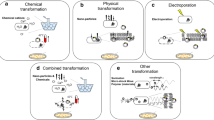Summary
Many plasmids belonging to the F incompatibility groups contain more than one basic replicon. The chimeric plasmid pCG86 is an example of such a multireplicon plasmid. The two basic replicons of pCG86, RepFIIA/FIC and RepFIB have been cloned and re-ligated, the copy numbers of the clones have been determined, and the incompatibility behavior of plasmids containing the ligated replicons and the individual replicons has been studied. The bireplicon plasmids are not expected to be incompatible as recipients with monoreplicon RepFIB or RepFIIA/RepFIC plasmids, since when one replicon is challenged by an incoming replicon, the other should be able to handle the plasmid's replication. In our studies, we found that challenge with either monoreplicon plasmid resulted in incompatibility. This incompatibility was increased in bireplicon plasmids in which RepFIB was duplicated. We conclude that in the bireplicon plasmids, challenging the replication control of one replicon by an incompatible plasmid can interfere with the replication originating from the second replicon.
Similar content being viewed by others
References
Abeles AL (1986) P1 plasmid replication: purification and DNA-binding activity of the replication protein. J Biol Chem 261:3548–3555
Austin S, Hart F, Abeles A, Steinberg N (1982) Genetic and physical map of the P1 miniplasmid. J Bacteriol 152:63–71
Bergquist PL, Lane HED, Malcolm L, Downard RA (1982) Molecular homology and incompatibility in the IncFI plasmid group. J Gen Microbiol 128:223–238
Bergquist PL, Saadi S, Maas WK (1986) Distribution of basic replicons having homology with RepFIA, RepFIB and RepFIC among IncF Group Plasmids. Plasmid 15:19–34
Couturier M, Bex F, Bergquist PL, Maas WK (1988) Identification and classification of bacterial plasmids. Microbiol Rev 52:375–395
Figurski DH, Meyer RJ, Helinski DR (1979) Suppression of ColE1 replication properties by the Inc P-1 plasmid RK2 in hybrid plasmids constructed in vitro. J Mol Biol 133:295–318
Gardner R, McAnulty J, Feher E, Lane D (1985) Location of rep and inc sequences in the F secondary replicon. Plasmid 13:145–148
Kado CI, Liu S-T (1981) Rapid procedure for detection and isolation of large and small plasmids. J Bacteriol 145:1365–1373
Maas R (1983) An improved colony hybridization method with significantly increased sensitivity for detection of single genes. Plasmid 10:296–298
Maas WK, Davis BD (1950) Pantothenate studies I: interference by D-serine and L-aspartic acid with pantothenate synthesis in Escherichia coli. J Bacteriol 60:733–745
Maniatis T, Fritsch EF, Sambrook J (1982) Molecular cloning: a laboratory manual. Cold Spring Harbor Laboratory Press, Cold Spring Harbor, New York
Mazaitis AJ, Maas R, Maas WK (1981) Structure of a naturally occurring plasmid with genes for enterotoxin production and drug resistance. J Bacteriol 145:97–106
Miki T, Easton AM, Rownd RH (1980) Cloning of replication, incompatibility, and stability functions of R plasmid NR1. J Bacteriol 141:87–99
Miller JH (1972) Experiments in Molecular Genetics. Cold Spring Harbor Laboratory Press, Cold Spring Harbor, New York
Nordström K, Molin S, Light J (1984) Control of replication of bacterial plasmids: genetics, molecular biology, and physiology of the plasmid R1 system. Plasmid 12:71–90
Pal SK, Chatoraj DK (1988) P1 plasmid replication: Initiator sequestration isiinadequate to explain control by initiator-binding sites. J Bacteriol 170:3554–3560
Pfister A, DeVries JK, Maas WK (1976) Expression of a mutation affecting F incompatibility in the integrated but not the autonomous state of F. J Bacteriol 127:348–353
Picken RN, Mazaitis AJ, Saadi S, Maas WK (1984) Characterization of the basic replicons of the chimeric R/Ent plasmid pCG86 and the related Ent plasmid P307. Plasmid 12:10–18
Picken RN, Mazaitis AJ, Maas R, Maas WK (1985) Increased production of heat-labile enterotoxin as a result of Tn3 insertion into a chimeric R/Ent plasmid. In: Takeda Y, Miwatani T (eds) Bacterial Diarrheal Diseases. KTK Scientific Publishers, Tokyo, p 201
Prentki P, Krisch H (1984) In vitro insertional mutagenesis with a selectable DNA fragment. Gene 29:303–313
Pritchard RH, Grover NB (1981) Control of plasmid replication and its relationship to incompatibility. In: Levy S, Clowes RC, Koenig EL (eds) Molecular Biology, Pathogenicity, and Ecology of Bacterial Plasmids. Plenum Press, New York London, pp 271–278
Rigby PWJ, Dieckmann M, Rhodes C, Berg P (1977) Labeling deoxyribonucleic acid to high specific activity invitro by nick translation with DNA polymerase I. J Mol Biol 113:237–251
Saadi S, Maas WK, Hill DF, Bergquist PL (1987) Nucleotide sequence analysis of RepFIC, a basic replicon in IncF1 plasmids P307 and F and its relation to the RepA replicon of IncFII plasmids. J Bacteriol 164:1836–1846
Saul D, Spiers AJ, McAnulty J, Gibbs MG, Bergquist PL, Hill DF (1989) Nucleotide sequence and replication characteristics of RepFIB, a basic replicon of incF plasmids. J Bacteriol 171:2697–2707
Timmis K, Cabello F, Cohen SN (1975) Cloning, isolation, and characterization of replication regions of complex plasmid genomes. Proc Natl Acad Sci USA 72:2242–2246
Tsutsui H, Matsubara K (1981) Replication control and switch-off function as observed with a mini-F factor plasmid. J Bacteriol 147:509–516
Womble D, Rownd RH (1986) Regulation of IncFII plasmid DNA replication. J Mol Biol 192:259–548
Womble D, Dong X, Wu RP, Luckow VA, Martinez AF, Rownd RH (1984) IncFII plasmid incompatibility product and its target are both RNA transcripts. J Bacteriol 160:28–35
Author information
Authors and Affiliations
Additional information
Communicated by R. Devoret
Rights and permissions
About this article
Cite this article
Maas, R., Saadi, S. & Maas, W.K. Properties and incompatibility behavior of miniplasmids derived from the bireplicon plasmid pCG86. Molec Gen Genet 218, 190–198 (1989). https://doi.org/10.1007/BF00331268
Received:
Issue Date:
DOI: https://doi.org/10.1007/BF00331268




